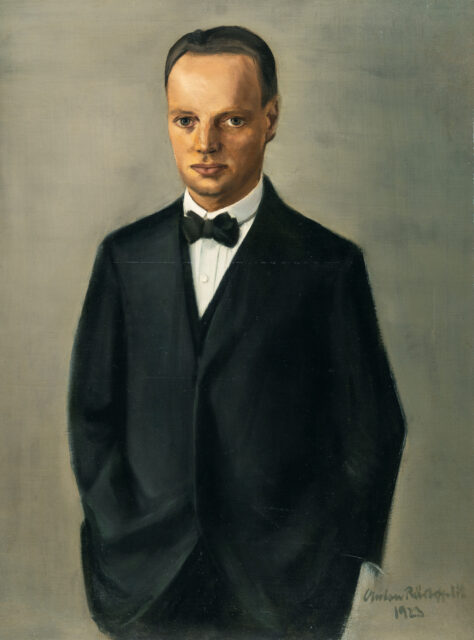Portrait of Dr. Georg Lüttke
Details
Literature: Herzog, Günter, Anton Räderscheidt, Cologne 1991, with black and white ill. no. 16, p. 29; Ansenk, Emily (ed.), Schilders van een andere werkelijkheid in de collectie van het Scheringa Museum voor Realisme, Zwolle 2006, p. 104f., with col. illus.; Van der Giessen, Belia (ed.), Nieuw realisme. 159 kunstwerken uit de collectie van het voormalige Scheringa Museum voor Realisme, Zwolle 2010, p. 89, with col. illus.Exhibitions:Neue Sachlichkeit. Zwölf Maler zwischen den Kriegen, Galerie of Abercron, Cologne 1975, cat. no.61, with black and white ill. p. 39; Neue Sachlichkeit und Realismus. Kunst zwischen den Kriegen, Museum des 20. Jahrhunderts, Vienna 1977, cat. no.131, with black and white ill. p. 83; Neue Sachlichkeit and German Realism of the Twenties, Hayward Art Gallery, London 1978/79, no. 190, with black and white ill. p. 17, with label on the reverse on the stretcher; Anton Räderscheidt 1892-1970: Retrospektive, Josef-Haubrich-Kunsthalle, Cologne 1993, cat. no.10, with col. illus. p. 79; Der kühle Blick: Realismus der Zwanzigerjahre in Europa und Amerika, Kunsthalle der Hypo-KulturFoundation, Munich 2001, with col. illus. p. 271. Provenance: Dr. Georg Lüttke, Cologne/Berlin; Galerie of Abercron, Munich 1978; Barry Friedman Ltd., New York;collection of Miles Lourie, New York; Galerie Michael Haas, Berlin; Scheringa Museum voor Realisme, Spanbroek; Christie’s, Amsterdam 27.11.2012, lot 37.
Description
• Räderscheidt’s earliest commissioned portrait
• From the important time period within his oeuvre in which he was influenced by New Objectivity in the early 1920s
• Characteristic frontal, three-quarter view, used in Räderscheidt’s portraits until the 1960s
At his father’s request, Anton Räderscheidt initially began training as a drawing teacher, an apprenticeship that he only completed in 1917 – interrupted by war and injury. He then worked as a trainee teacher in Cologne for two years, but refused to become a civil servant and worked as a freelance artist from 1918 onwards. Räderscheidt joined the avant-garde art scene in the Rhineland and had contact with the Cologne “progressives” and the Dada circle around Max Ernst. He founded the “Stupid” group with Franz Wilhelm Seiwert and Heinrich Hoerle. After an Expressionist and a Constructive phase, Räderscheidt developed his own form of magical realism in the early 1920s under the influence of “Pittura metafisica”. As an outstanding representative of this movement, he took part in the “New Objectivity” exhibition in Mannheim in 1925. As Räderscheidt always lived in precarious financial circumstances, he recognised early on the possibilities of portrait painting to secure his livelihood. From 1923 onwards, he painted portraits of gallery owners, collectors and friends, as well as Cologne museum directors, professors, merchants and manufacturers. He was soon recognised as Cologne’s portraitist par excellence. The “Portrait of Dr Georg Lüttke” is considered Räderscheidt’s earliest surviving commissioned portrait, which was to be followed by numerous others. Dr Georg Lüttke is the publisher of the magazine “Metallwirtschaft” and chairman of the “Metallgesellschaft”. Together with his wife Gertrud, he discovered the young painter’s work and developed a close friendship with Räderscheidt. Even before they moved from Cologne to Berlin in 1923, he commissioned Räderscheidt to paint his portrait in the highly fashionable New Objectivity style: against a neutral light grey background, in a fine black suit, yet nonchalantly posing with both hands in his trouser pockets. His alert eyes and high forehead stand out sharply. Räderscheidt has succeeded in creating an intimate yet imposing portrait. The form chosen here, the frontal three-quarter figure, would continue to characterise his portraits until the 1960s. After a few years, however, he loosened up the strong contours and smooth painting style of New Objectivity and worked with much more impasto. This can already be seen, for example, in the portrait of Gertrud Lüttke, painted five years later in 1928.
* All results incl. buyer’s premium (27%) without VAT. No guarantee, subject to error.
** All post-auction prices excl. buyer's premium and VAT. No guarantee, subject to error.
*** Conditional Sale: The bid was accepted below the limit. Acquisition of the work may still be possible in our post-auction sale.
R = regular taxation
N = differential taxation on works of art which originate from a country outside of the EU
The private or commercial use of images shown on this Website, in particular through duplication or dissemination, is not permitted. All rights reserved.


